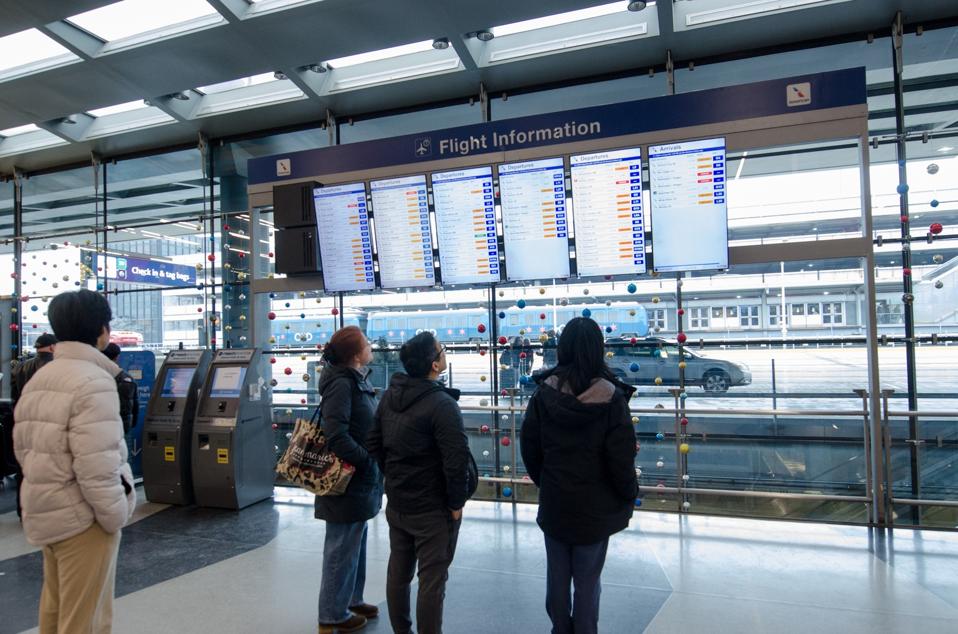
Chicago O’Hare is a great hub for two airlines, but sometimes passengers face winter delays as in January 2025. (Photo by Jacek Boczarski/Anadolu)
Anadolu via Getty Images
Perhaps United CEO Scott Kirby has gotten a little ahead of himself in declaring victory over American at Chicago O’Hare International Airport.
Yes, United is the hometown airline, but as American CEO Robert Isom said on the American earnings call on Thursday, “Of course, Chicago can support two hub carriers. It’s been doing it forever. American has served Chicago now for almost 100 years, and we’re looking to serve it well into the future.
“It’s going to be our third largest hub,” Isom said. “There aren’t many 500 departure hubs out there. “
Six hours after the conclusion of the American earnings call where Isom spoke repeatedly about O’Hare growth, United announced it will add ten new domestic destinations at O’Hare. “The new destinations facilitate even more connectivity through Chicago, driving further economic growth in United’s hometown city,” United said.
For the moment, American has about 480 daily departures to 160 destinations, while United has about 500 daily departures to 200 destinations, according to the airlines’ fact sheets.
Kirby has long said that United is winning the battle for dominance at O’Hare. He stepped up the attacks in the past few months, telling airline journalist Brian Sumers that American is losing $800 million annually at the airport, and apparently telling a group of United pilots that American may have to dehub ORD, as related by X poster JonNYC.
In a chart that was part of its first quarter earnings report, United showed that its share of local passengers at ORD grew from 38% in 2015 to 51% in 2024, while American’s share declined from 39% to 29% during the same time period.
After the earnings call, it seems clear the decline will cease.
Isom revealed that that enrollments in American frequent flyer accounts increased 7% in the third quarter “with our highest growth in enrollments coming from Chicago, which was up approximately 20% year-over-year.
“That’s a really remarkable number,” Isom said. “We’re going to take advantage of that desire for our product, as I mentioned. As we look out into the future, we anticipate that Chicago will return to its rightful place as one of our largest and more profitable hubs. Capacity, at least in Chicago, as we take a look out, we’re going to fly what we can. It’ll be, again, over 500 departures.”
500 daily departures “ensures that there is service, competitive service,” Isom said. “I think that’s probably the thing that maybe a competitor doesn’t like, that we’re going to be there. We’re going to be investing in Chicago, and there aren’t going to be really any impediments to us building out the network and the footprint that we need there.”
In its post-call announcement, United said its new routes are enable by the addition of five new gates it received in the city’s annual reallocation process. At the start of the year, of O’Hare’s 201 gates, United had 90 and American had 71.
“United is already flying its busiest schedule in history at O’Hare, and now these additional gates have unlocked new opportunities to intertwine cities across the country, serve more customers in Chicago and strengthen our hometown hub.” Patrick Quayle, United senior vice president of global network planning and alliances, said in prepared statement.
Six of the new destinations will be served exclusively by United from O’Hare. Santa Barbara, Eugene, Paducah and Lynchburg will all get daily service beginning in spring 2026. Monterey and St. George, Utah, will get Saturday seasonal service. Three non-exclusive markets will get daily service starting in the spring. They are Rochester, Minn; Wausau, Wis.; Marquette, Mich. Also, Idaho Falls will get Saturday seasonal service. United will also resume Chicago-Tel Aviv in nine days and plans to make Chicago-Dublin a year-round route.
Dennis Tajer, spokesman for Allied Pilots Association, which represents 16,000 American pilots, said, “Scott Kirby wants to decimate the competition, so it’s good to see American punch back. Seeing punch back is better than seeing surrender.”
While it’s positive to see 20% growth in Chicago credit card holders, Tajer said, “In order for lost passengers to come back, you have to be present. But your reach has to be global, and that’s that challenge. In Chicago, the reach of American is less than the reach of United, especially internationally. Hopefully we can catch up.
“We have a lot more people signing up for our gym,” Tajer said. “Now we just have to make sure they go to the gym.”
